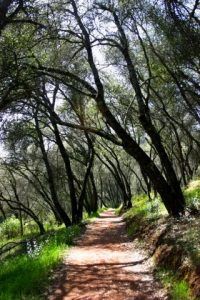Native Oaks, California’s Other Mother Lode
Native oak trees have provided valuable services to California residents for centuries, if not millennia. On Thursday, October 5, at 7:00 p.m. the University of California Cooperative Extension, in collaboration with the Willow Springs Home Owners’ Association, will host a talk about the value of native oak trees to property owners. The free, hour-long presentation will be held in the Willow Springs Clubhouse and will include information about caring for native oaks and how to plant new oaks, if your property does not contain oak trees. The public is invited.
The oak woodlands and streams we know as the Mother Lode were once home to thousands of native Californians. Indian Grinding Rock State Historic Park, just outside of Jackson, is named for the Chaw’se, the Miwok’s name for a grinding rock, a slab of stone on which they ground acorns and other seeds.
EUROPEAN INFLUENCES: In the mid 18th and 19th centuries, new Spanish residents cleared land to plant their crops in the soils enriched by centuries of old oaks. They also cut oaks to fuel their fires and to frame timbers. The Mexicans who followed used extracts from live and tanbark oaks to tan hides; by the late 1800s, “rapacious harvest of tanbarks” was believed by some botanists to threaten the tanbarks’ survival.
THE GOLD RUSH: Tens of thousands of men rushed to California in the gold rush from 1849 to the 1850s. The new residents needed fuel for their camps and their steam locomotives. Coast live oak was especially valued as it was easily split and burned slow and hot. Other oaks were turned into wagon wheels and tongues, axles, and tool handles. Oaks became charcoal for blacksmith ovens and fed smelters that extracted mercury, silver, and copper from parent ores. Even bakery ovens were fired with countless oaks.
Oak seedlings and acorns fed cattle and hogs as land was cleared throughout the state and oak logs warmed settlers’ homes. The local “hanging tree” was almost always an oak.
MODERN TIMES: Following World War II, intensive land development consumed oak woodlands. Hamlets sprawled into cities, cabin clearings morphed into industrial parks, and millions of acres were converted to agriculture. Over 30,000 acres of oak woodlands are converted each year for residential and commercial use.. But unlike the Mother Lode’s gold, the trees can stabilize and thrive. Oak trees are not in a hurry—they are slow-growing and have lived for centuries on our parched summer hills and meadows. So too, the blue, black, and live oaks found in our gardens today require little or no summer water to remain healthy.
To learn about oaks, their needs, and how to share our oak heritage with our grandchildren’s grandchildren, start with a glimpse into early life at Indian Grinding Rock State Park, 209-296-7488, http://www.parks.ca.gov/?page_id=553 The grinding rocks and the Park’s beautiful museum are easily accessible, just a short walk from the parking area.
For $1 the museum offers a booklet, “Bountiful Land, A guide to the Miwok Plant Trail,” a guide to a one-half mile walk through meadow, creek, and woodland habitats. Many of these same plants make excellent additions to today’s water-conserving home gardens; look for them in retail nurseries and at native plant sales.
For more about modern day oak challenges and solutions visit the University of California’s Oak Woodland Management Program at http://ucanr.edu/sites/oak_range/ or download Living among the Oaks http://anrcatalog.ucanr.edu/pdf/21538.pdf published by the Agriculture and Natural Resources division of the University of California.
Vera Strader is a Sonora-based University of California Cooperative Extension Master Gardener of Tuolumne County who believes that the mature trees and the wildlife of the Sierra Foothills are irreplaceable.

